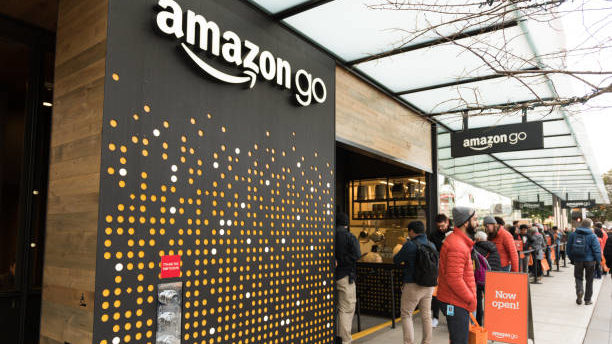Editorial Note: Forbes may earn a commission on sales made from partner links on this page.- test default
Amazon-branded credit cards aren’t new. But with the company’s recent acquisition of Whole Foods, these credit cards can provide more rewards than ever before.
There are four Amazon credit cards to consider, each with a unique set of benefits – and drawbacks. Are they worth the hype for both Prime and non-Prime members alike? Let’s take a look.
Amazon Prime Rewards Visa Signature Card*
Launched in 2017, this Chase card is exclusively for Amazon Prime members, who receive a $70 Amazon gift card upon approval.
The good
With no annual fee or foreign transaction fees, this card offers major opportunities for cash back. As a Prime member, you get 5% back on purchases at Amazon.com and Whole Foods, 2% back at restaurants, gas stations and drugstores, and 1% back on all other purchases. This means that every dollar spent equates to $0.05 (or 5 points) in rewards, $0.03 (or 3 points) in rewards, or $0.01 (or 1 point) in rewards.
The 5% cash back landed this card on the Forbes list of the best cash back cards for 2019.
The catch
Though you can redeem your points anytime for “eligible purchases” at Amazon, you won’t be able to redeem them for cash until you hit 2,000 points, or $20. This means that you would have to spend $400 at Amazon or Whole Foods in order to be able to cash out. You can also redeem rewards for gift cards and travel rewards.
The purchase and balance transfer APRs are average: 16.49% to 24.49%, based on your creditworthiness and subject to change. And while there is technically no annual fee associated with this card, you do have to have an Amazon Prime membership, which costs $119 a year. Amazon’s fee beats out issuers like American Express and some Citibank cards, but is higher than those of Wells Fargo or Bank of America. But at least with an Amazon Prime membership, you are getting free 2-day shipping and access to Amazon Prime Video, among other benefits.
At $119, you’d have to spend $2,380 on Amazon products or at Whole Foods to earn enough cash back to pay for your Prime subscription. That doesn’t, however, factor in the value of free two-day shipping or other Prime benefits. It also doesn’t factor in spending in other categories that also earn rewards, although at lower rates.
Young woman with credit card and headphones online shopping at laptop on living room sofa
So if you’re already subscribing to Prime for the other benefits, or you are a devoted and frequent Amazon and Whole Foods customer, this card could be a great deal for you. If not, there are plenty of other cards, including the Citi Double Cash card and Capital One Quicksilver card, that offer high cash back rewards on every purchase without an annual fee.
Amazon Rewards Visa Signature Card*
This card is similar to the one above, but is an option for non-Amazon Prime members. Upon opening the card, you will receive a $50 Amazon gift card. This card, as well as the Prime Rewards card, offer other benefits such as lost luggage reimbursement and travel accident insurance.
The Prime Rewards card offers 3% back on purchases at Amazon.com and Whole Foods, 2% back at restaurants, gas stations and drugstores, and just 1% back on all other purchases. There is no annual fee for the card.
While 3% back on Amazon.com and Whole Foods purchases is less than the 5% users of the Amazon Prime Rewards card earn, you don’t have to shell out $119 a year for an Amazon Prime membership. But again, cards like the Citi Double Cash card offer 2% cash back on all purchases, and might be a better choice unless you do much of your spending at Whole Foods, Amazon, restaurants, gas stations and drugstores.
Amazon.com Store Card
First things first. This card, offered by Synchrony Bank, can only be used while shopping at Amazon. There are two types of store cards, offered for Prime and non-Prime members. Prime members will earn 5% back on all Amazon.com purchases while using the card. As with the Visa cards, these cash back rewards can be redeemed for purchases on Amazon, or as statement credits.
Both types of store cards offer interesting 0% financing options. They are:
- No interest on purchases of $149 or more if paid in full within six months.
- No interest on purchases of $599 or more if paid in full within 12 months.
- No interest on select Amazon purchases if paid in full within 24 months.
It’s important to note that these are deferred interest offers. If you don’t pay the full amount by the time specified, you will be charged the interest incurred from the purchase date. Unfortunately, these special financing offers can’t be combined with the 5% cash back benefit.
The card also offers an “Equal Pay Offer.” On select Amazon purchases, you will be able to pay with equal monthly payments and a 0% APR until the purchase is paid for in full. Again, this offer can’t be combined with the 5% rewards benefit.
While this card has no annual fee, the purchase APR is steep: 28.24%. While the 0% financing offers are intriguing, it’s hard to find any other benefits to this card for non-Prime members, besides a $60 Amazon gift card offered upon opening the card.
Instead, look for cards that offer 0% introductory APRs, such as the Capital One Quicksilver card. If you are a Prime member, you should only opt for this card if you need to take advantage of the financing options to buy big ticket items. If not, the Amazon Prime Rewards Visa Signature card is more versatile.












